Carrier 50VL-A User Manual
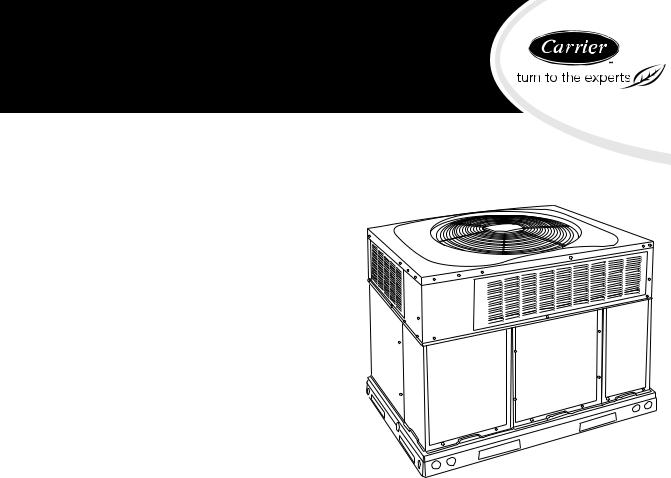
50VL---A
Performancet 14 SEER Single---Packaged Air Conditioner System with Puron® (R---410A) Refrigerant
Single and Three Phase
2---5 Nominal Tons (Sizes 24---60)
Installation Instructions
NOTE: Read the entire instruction manual before starting the installation.
NOTE: Installer: Make sure the Owner’s Manual and Service |
|
Instructions are left with the unit after installation. |
|
TABLE OF CONTENTS |
|
|
PAGE |
SAFETY CONSIDERATIONS . . . . . . . . . . . . . . . . . . . . . |
. . 1-2 |
INTRODUCTION . . . . . . . . . . . . . . . . . . . . . . . . . . . . . . . |
. . . . 2 |
RECEIVING AND INSTALLATION . . . . . . . . . . . . . . . . |
. 2-10 |
Check Equipment . . . . . . . . . . . . . . . . . . . . . . . . . . . . . . |
. . . . 2 |
Identify Unit . . . . . . . . . . . . . . . . . . . . . . . . . . . . . . . . |
. . . . 2 |
Inspect Shipment . . . . . . . . . . . . . . . . . . . . . . . . . . . . . |
. . . . 2 |
Provide Unit Support . . . . . . . . . . . . . . . . . . . . . . . . . . . |
. . . . 2 |
Roof Curb . . . . . . . . . . . . . . . . . . . . . . . . . . . . . . . . . . |
. . . . 2 |
Slab Mount . . . . . . . . . . . . . . . . . . . . . . . . . . . . . . . . . |
. . . . 2 |
Provide Clearances . . . . . . . . . . . . . . . . . . . . . . . . . . . . . |
. . . . 7 |
Field Fabricate Ductwork . . . . . . . . . . . . . . . . . . . . . . . . |
. . . . 7 |
Rig and Place Unit . . . . . . . . . . . . . . . . . . . . . . . . . . . . . |
. . . . 7 |
Inspection . . . . . . . . . . . . . . . . . . . . . . . . . . . . . . . . . . |
. . . . 7 |
Rigging/Lifting of Unit . . . . . . . . . . . . . . . . . . . . . . . . |
. . . . 7 |
Connect Condensate Drain . . . . . . . . . . . . . . . . . . . . . . . |
. . . . 8 |
Install Duct Connections . . . . . . . . . . . . . . . . . . . . . . . . . |
. . . . 8 |
Configuring Units for Downflow (Vertical) Discharge |
. . . . 8 |
Install Electrical Connections . . . . . . . . . . . . . . . . . . . . . |
. . . . 9 |
High-Voltage Connections . . . . . . . . . . . . . . . . . . . . . |
. . . . 9 |
Special Procedures for 208v Operation . . . . . . . . . . . . |
. . . 10 |
Control Voltage Connections . . . . . . . . . . . . . . . . . . . . |
. . . 10 |
Standard Connection . . . . . . . . . . . . . . . . . . . . . . . . . . |
. . . 10 |
Transformer Protection . . . . . . . . . . . . . . . . . . . . . . . . |
. . . 10 |
PRE-START-UP . . . . . . . . . . . . . . . . . . . . . . . . . . . . . . . . |
. . . 12 |
START-UP . . . . . . . . . . . . . . . . . . . . . . . . . . . . . . . . . . . . . |
12-14 |
Check for Refrigerant Leaks . . . . . . . . . . . . . . . . . . . . . . |
. . . 12 |
Start-Up Adjustments . . . . . . . . . . . . . . . . . . . . . . . . . . . |
. . . 12 |
Checking Cooling Control Operation . . . . . . . . . . . . . |
. . . 12 |
Checking and Adjusting Refrigerant Charge . . . . . . . . |
. . . 12 |
Indoor Airflow and Airflow Adjustments . . . . . . . . . . |
. . . 13 |
Continuous Fan Operation . . . . . . . . . . . . . . . . . . . . . |
. . . 14 |
Cooling Sequence of Operation . . . . . . . . . . . . . . . . . . |
. . . 14 |
MAINTENANCE . . . . . . . . . . . . . . . . . . . . . . . . . . . . . . . . |
24-26 |
Air Filter . . . . . . . . . . . . . . . . . . . . . . . . . . . . . . . . . . . |
. . . 24 |
Indoor Blower and Motor . . . . . . . . . . . . . . . . . . . . . . |
. . . 24 |
Outdoor Coil, Indoor Coil, and Condensate Drain Pan |
. . . 25 |
Outdoor Fan . . . . . . . . . . . . . . . . . . . . . . . . . . . . . . . . |
. . . 25 |
Electrical Controls and Wiring . . . . . . . . . . . . . . . . . . |
. . . 25 |
Refrigerant Circuit . . . . . . . . . . . . . . . . . . . . . . . . . . . . |
. . . 26 |
Evaporator Airflow . . . . . . . . . . . . . . . . . . . . . . . . . . . |
. . . 26 |
Puron Items . . . . . . . . . . . . . . . . . . . . . . . . . . . . . . . . . |
. . . 26 |
TROUBLESHOOTING . . . . . . . . . . . . . . . . . . . . . . . . . . . |
. . . 27 |
START-UP CHECKLIST . . . . . . . . . . . . . . . . . . . . . . . . . |
. . . 27 |
A09033
Fig. 1 - Unit 50VL-A
SAFETY CONSIDERATIONS
Improper installation adjustment, alteration, service, maintenance, or use can cause explosion, fire, electrical shock, or other conditions which may cause death, personal injury, or property damage. Consult a qualified installer, service agency, or your distributor or branch for information or assistance. The qualified installer or agency must use factory-authorized kits or accessories when modifying this product Refer to the individual instructions packaged with the kits or accessories when installing.
Follow all safety codes. Wear safety glasses, protective clothing, and work gloves. Use quenching cloth for brazing operations. Have a fire extinguisher available. Read these instructions thoroughly and follow all warnings or cautions included in literature and attached to the unit. Consult local building codes, the current editions of the National Electrical Code (NEC) NFPA 70.
In Canada refer to the current editions of the Canadian electrical Code CSA C22.1.
Recognize safety information. This is the safety-alert symbol  . When you see this symbol on the unit and in instructions or manuals, be alert to the potential for personal injury. Understand these signal words; DANGER, WARNING, and CAUTION. These words are used with the safety-alert symbol. DANGER identifies the most serious hazards which will result in severe personal injury or death. WARNING signifies hazards which could result in personal injury or death. CAUTION is used to identify unsafe practices which may result in minor personal injury or product and property damage. NOTE is used to highlight suggestions which will result in enhanced installation, reliability, or operation.
. When you see this symbol on the unit and in instructions or manuals, be alert to the potential for personal injury. Understand these signal words; DANGER, WARNING, and CAUTION. These words are used with the safety-alert symbol. DANGER identifies the most serious hazards which will result in severe personal injury or death. WARNING signifies hazards which could result in personal injury or death. CAUTION is used to identify unsafe practices which may result in minor personal injury or product and property damage. NOTE is used to highlight suggestions which will result in enhanced installation, reliability, or operation.
1

50VL--A
!WARNING
ELECTRICAL SHOCK HAZARD
Failure to follow this warning could result in personal injury or death.
Before installing or servicing system, always turn off main power to system and install lockout tag. There may be more than one disconnect switch. Turn off accessory heater power switch if applicable.
!WARNING
PERSONAL INJURY AND ENVIRONMENTAL HAZARD
Failure to relieve system pressure could result in personal injury and/or death.
1. Relieve pressure and recover all refrigerant before servicing existing equipment, and before final unit disposal. Use all service ports and open all flow-control devices, including solenoid valves.
2. Federal regulations require that you do not vent refrigerant into the atmosphere. Recover during system repair or final unit disposal.
!CAUTION
CUT HAZARD
Failure to follow this caution may result in personal injury.
When removing access panels (see Fig. 17) or performing maintenance functions inside your unit, be aware of sharp sheet metal parts and screws. Although special care is taken to reduce sharp edges to a minimum, be extremely careful when handling parts or reaching into the unit.
INTRODUCTION
The 50VL-A packaged air conditioner is fully self-contained and designed for outdoor installation (See Fig.1 ). See Fig. 2 and 3 for unit dimensions. All unit sizes have discharge openings for both horizontal and downflow configurations, and are factory shipped with all downflow duct openings covered. The unit may be installed either on a rooftop or on a ground-level cement slab. (See Fig. 4 for roof curb dimensions.)
RECEIVING AND INSTALLATION
Step 1 — Check Equipment
IDENTIFY UNIT
The unit model number and serial number are printed on the unit informative plate. Check this information against shipping papers.
INSPECT SHIPMENT
Inspect for shipping damage before removing packaging materials. If unit appears to be damaged or is torn loose from its anchorage, have it examined by transportation inspectors before removal. Forward claim papers directly to transportation company. Manufacturer is not responsible for any damage incurred in transit. Check all items against shipping list. Immediately notify the nearest equipment distribution office if any item is missing. To prevent loss or damage, leave all parts in original packages until installation.
If the unit is to be mounted on a curb in a downflow application, review Step 7 to determine which method is to be used to remove the downflow panels before rigging and lifting into place. The panel removal process may require the unit to be on the ground.
Step 2 — Provide Unit Support
IMPORTANT: The unit must be secured to the curb by installing screws through the bottom of the curb flange and into the unit base rails. When installing large base units onto the common curb, the screws must be installed before allowing the full weight of the unit to rest on the curb. A minimum of six screws are required for large base units. Failure to secure unit properly could result in an unstable unit. See Warning near Rigging/Lifting information and accessory curb instructions for more details.
For hurricane tie downs, contact distributor for details and PE (Professional Engineering) Certificate if required.
ROOF CURB
Install accessory roof curb in accordance with instructions shipped with curb (See Fig. 4). Install insulation, cant strips, roofing, and flashing. Ductwork must be attached to curb.
IMPORTANT: The gasketing of the unit to the roof curb is critical for a water tight seal. Install gasketing material supplied with the roof curb. Improperly applied gasketing also can result in air leaks and poor unit performance.
Curb should be level to within 1/4 in. (6.35 mm) (See Fig 6). This is necessary for unit drain to function properly. Refer to accessory roof curb installation instructions for additional information as required.
Installation on older “G” series roof curbs.
Two accessory kits are available to aid in installing a new “G” series unit on an old “G” roof curb.
1.Accessory kit number CPADCURB001A00, (small chassis) and accessory kit number CPADCURB002A00, (large chassis) includes roof curb adapter and gaskets for the perimeter seal and duct openings. No additional modifications to the curb are required when using this kit.
2.An alternative to the adapter curb is to modify the existing curb by removing the outer horizontal flange and use accessory kit number CPGSKTKIT001A00 which includes spacer blocks (for easy alignment to existing curb) and gaskets for the perimeter seal and duct openings. This kit is used when existing curb is modified by removing outer horizontal flange.
!CAUTION
UNIT/STRUCTURAL DAMAGE HAZARD
Failure to follow this caution may result in property damage.
Ensure there is sufficient clearance for saw blade when cutting the outer horizontal flange of the roof curb so there is no damage to the roof or flashing.
SLAB MOUNT
Place the unit on a solid, level concrete pad that is a minimum of 4 in. (102 mm) thick with 2 in. (51 mm) above grade. The slab should extend approximately 2 in. (51 mm) beyond the casing on all 4 sides of the unit (See Fig. 7). Do not secure the unit to the slab except when required by local codes.
2
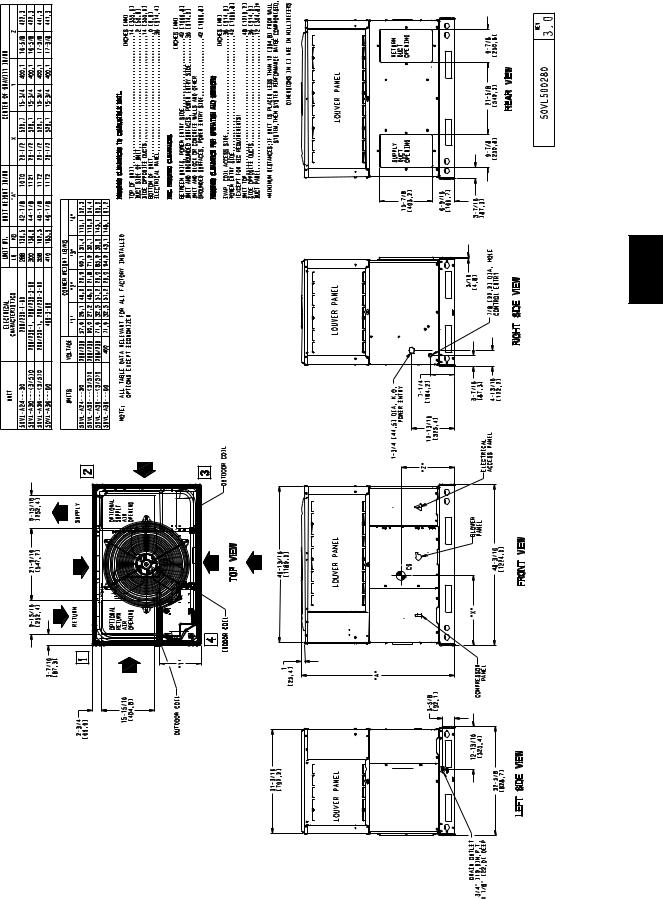
50VL--A
A09462
Fig. 2 - 50VL-A24-36 Unit Dimensions
3
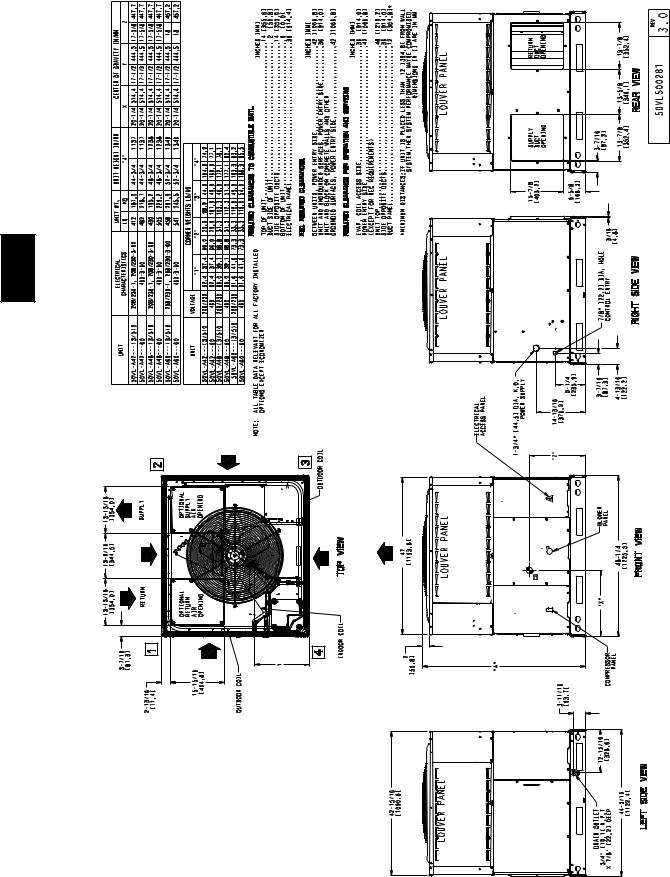
50VL--A
A09463
Fig. 3 - 50VL-A42-60 Unit Dimensions
4

HVAC unit |
HVAC unit |
base rails |
basepan |
|
Sealing |
|
Gasket |
|
Roofcurb |
Anchor screw |
Wood nailer* |
Flashing field |
|
supplied |
Roofcurb* |
|
Insulation |
Roofing material |
(field supplied) |
|
|
field supplied |
|
Cant strip |
|
field supplied |
|
*Provided with roofcurb
A09090




 B
B
G C
F |
H |
A
D
SMALL/COMMON CURB
Dashed lines show cross support location for large basepan units.
E
A09413
ROOF CURB DETAIL
|
B |
|
|
|
C |
SMALL |
|
|
SUPPLY |
||
G |
BASE |
||
AIR |
UNIT |
||
|
F A |
H |
|
|
|
|
|
|
|
LARGE |
|
|
|
|
|
|
|
|
|
|
|
|||
|
|
|
|
|
|
RETURN |
|
|
BASE |
|
|
|
|
|
|
E |
|
AIR |
|
|
UNIT |
|
|
|
|
|
|
|
|
|
|
|
|
||
|
D |
|
|
|
|
|
|
|
|
|
|
|
|
|
|
|
|
UNIT PLACEMENT ON |
|
||||
|
|
|
|
|
|
COMMON CURB |
|
A09094 |
|||
|
LARGE CURB |
|
A09415 |
|
|
SMALL OR LARGE BASE UNIT |
|
||||
|
|
|
|
|
|
||||||
|
|
|
|
|
|
|
|
|
|
A09414 |
|
UNIT |
CATALOG |
A |
B |
B |
C |
D |
E |
F |
G |
H |
|
(small/common |
|||||||||||
IN. |
(large base) |
IN. |
IN. |
IN. |
IN. |
||||||
SIZE |
NUMBER |
base) |
IN. (mm) |
IN. (mm) |
|||||||
(mm) |
IN. (mm)* |
(mm) |
(mm) |
(mm) |
(mm) |
||||||
|
|
IN. (mm)* |
|
|
|||||||
|
|
|
|
|
|
|
|
|
|
||
Small |
CPRFCURB010A00 |
11 |
|
|
|
|
|
|
|
|
|
(279) |
|
|
|
|
32.4 |
|
|
|
|||
|
10 (254) |
|
|
|
|
30.6 (778) |
|
||||
or |
|
14 |
|
|
|
(822) |
|
|
|||
Large |
CPRFCURB011A00 |
|
|
|
|
|
|
|
|||
(356) |
|
14 (356) |
16 |
47.8 |
|
2.7 |
|
46.1 (1170) |
|||
|
|
|
|
|
|||||||
|
|
11 |
|
(406) |
(1214) |
|
(69) |
|
|||
|
CPRFCURB012A00 |
|
|
|
|
|
|||||
Large |
(279) |
14 (356) |
|
|
|
43.9 |
|
42.2 (1072) |
|
||
|
|
|
|
|
|
||||||
|
14 |
|
|
|
(1116) |
|
|
||||
|
CPRFCURB013A00 |
|
|
|
|
|
|
|
|||
|
(356) |
|
|
|
|
|
|
|
|
||
|
|
|
|
|
|
|
|
|
|
||
* Part Numbers CPRCURB010A00 and CPRCURB011A00 can be used on both small and large basepan units. The cross supports must be located based on whether the unit is a small basepan or a large basepan.
NOTES:
1.Roof curb must be set up for unit being installed.
2.Seal strip must be applied, as required, to unit being installed.
3.Roof curb is made of 16-gauge steel.
4.Attach ductwork to curb (flanges of duct rest on curb).
5.Insulated panels: 1-in. (25.4 mm) thick fiberglass 1 lb. density.
Fig. 4 - Roof Curb Dimensions
5
50VL--A
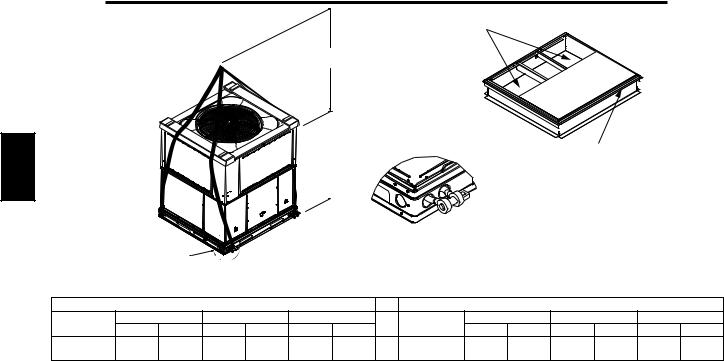
 CAUTION - NOTICE TO RIGGERS
CAUTION - NOTICE TO RIGGERS
 PRUDENCE - AVIS AUX MANIPULATEUR
PRUDENCE - AVIS AUX MANIPULATEUR
ACCESS PANELS MUST BE IN PLACE WHEN RIGGING.
PANNEAUX D'ACCES DOIT ÊTRE EN PLACE POUR MANIPULATION.
Use top skid as spreader bar. / Utiliser la palette du haut comme barre de répartition
DUCTS
MINIMUM HEIGHT: 36" (914.4 mm)
HAUTEUR MINIMUM
50VL--A
|
|
|
|
BANDE SCELLANT DOIT ÊTRE |
|
|
|
|
|
|
|
SEAL STRIP MUST BE IN |
||
UNIT HEIGHT |
PLACE BEFORE PLACING |
EN PLACE AVANT DE PLACER |
||
HAUTEUR D'UNITÉ |
UNIT ON ROOF CURB |
L'UNITÉ SUR LA BASE DE TOIT |
||
|
|
|
|
|
|
|
|
|
|
|
|
|
|
|
|
|
|
|
|
|
|
|
|
|
|
|
|
|
|
|
|
DETAIL A |
|
|
|
|
|
|
|
|
|
SEE DETAIL A |
|
|
|
|
VOIR DÉTAIL A |
|
|
|
|
|
|
|
|
|
|
|
|
|
|
|
|
|
|
|
|
||
|
|
VOIR DÉTAIL A |
|
|
|
|
|
|
|
|
50CY502286 2.0 |
|
||
|
|
|
|
|
|
|
|
|
|
|
|
|||
|
|
|
|
|
|
|
|
|
|
|
|
|
A09051 |
|
|
|
SMALL CABINET |
|
|
|
|
|
LARGE CABINET |
|
|
||||
Unit* |
|
24 |
30 |
|
|
36 |
Unit* |
42 |
|
|
48 |
|
60 |
|
lb |
kg |
lb |
kg |
lb |
kg |
lb |
kg |
lb |
kg |
lb |
kg |
|||
|
|
|||||||||||||
Rigging |
295 |
134 |
307 |
139 |
365 |
166 |
Rigging |
421 |
191 |
439 |
199 |
467 |
212 |
|
Weight |
Weight |
|||||||||||||
|
|
|
|
|
|
|
|
|
|
|
|
|||
* For 460 volt units, add 14 lb (6.35 kg) to the rigging weight. NOTE: See dimensional drawing for corner weighs.
Fig. 5 - 50VL-A Unit Suggested Rigging
6
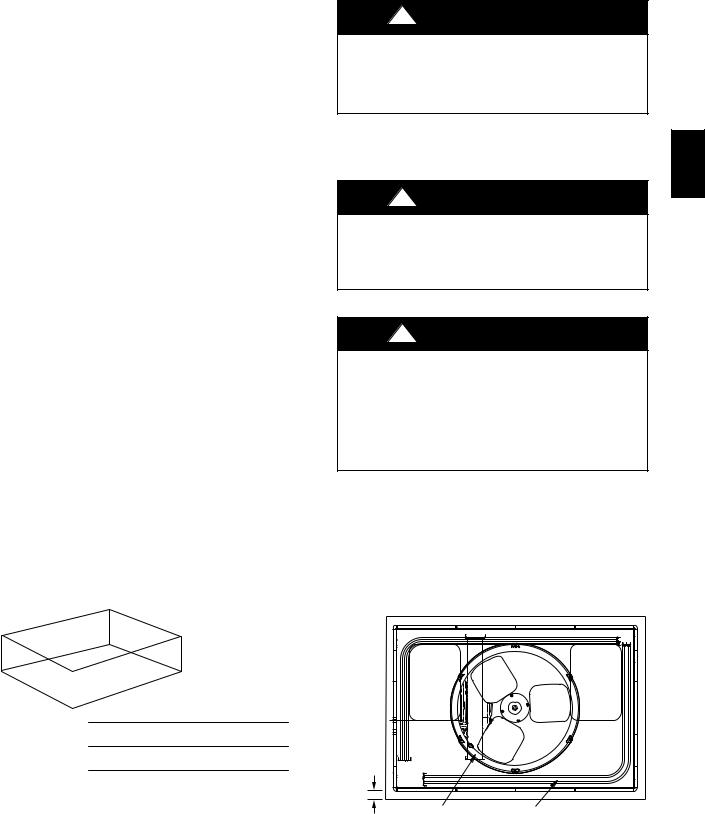
Step 3 — Provide Clearances
The required minimum service clearances are shown in Fig. 2 and 3. Adequate ventilation and outdoor air must be provided. The outdoor fan draws air through the outdoor coil and discharges it through the top fan grille. Be sure that the fan discharge does not recirculate to the outdoor coil. Do not locate the unit in either a corner or under an overhead obstruction. The minimum clearance under a partial overhang (such as a normal house overhang) is 48 in. (1219 mm) above the unit top. The maximum horizontal extension of a partial overhang must not exceed 48 in. (1219 mm) IMPORTANT: Do not restrict outdoor airflow. An air restriction at either the outdoor-air inlet or the fan discharge may be detrimental to compressor life.
Do not place the unit where water, ice, or snow from an overhang or roof will damage or flood the unit. Do not install the unit on carpeting or other combustible materials. Slab-mounted units should be at least 4 in. (102 mm) above the highest expected water
and runoff levels. Do not use unit if it has been under water.
Step 4 — Field-Fabricate Ductwork
Secure all ducts to roof curb and building structure on vertical discharge units. Do not connect ductwork to unit. For horizontal applications, unit is provided with flanges on the horizontal openings. All ductwork should be secured to the flanges. Insulate and weatherproof all external ductwork, joints, and roof openings with counter flashing and mastic in accordance with applicable codes.
Ducts passing through an unconditioned space must be insulated and covered with a vapor barrier. If a plenum return is used on a vertical unit, the return should be ducted through the roof deck to comply with applicable fire codes. See unit rating plate for any required clearances around ductwork. Cabinet return-air static shall not exceed -.25 IN. W.C.
Step 5 — Rig and Place Unit
Rigging and handling of this equipment can be hazardous for many reasons due to the installation location (roofs, elevated structures, etc.).
Only trained, qualified crane operators and ground support staff should handle and install this equipment.
When working with this equipment, observe precautions in the literature, on tags, stickers, and labels attached to the equipment, and any other safety precautions that might apply.
Training for operators of the lifting equipment should include, but not be limited to, the following:
1.Application of the lifter to the load, and adjustment of the lifts to adapt to various sizes or kinds of loads.
2.Instruction in any special operation or precaution.
3.Condition of the load as it relates to operation of the lifting kit, such as balance, temperature, etc.
Follow all applicable safety codes. Wear safety shoes and work gloves.
A |
|
|
|
|
C |
|
|
|
|
|
MAXIMUM ALLOWABLE |
||||
|
|
|
|||||
B |
|
|
DIFFERENCE in. (mm) |
||||
|
|
A-B |
|
B-C |
|
A-C |
|
1/4 |
(6.35) |
|
1/4 |
(6.35) |
1/4 |
(6.35) |
|
|
|
|
|
|
|
|
|
A07925
Fig. 6 - Unit Leveling Tolerances
INSPECTION
Prior to initial use, and at monthly intervals, all rigging shackles, clevis pins, and straps should be visually inspected for any damage, evidence of wear, structural deformation, or cracks. Particular attention should be paid to excessive wear at hoist hooking points and load support areas. Materials showing any kind of wear in these areas must not be used and should be discarded.
!WARNING
UNIT FALLING HAZARD
Failure to follow this warning could result in personal injury or death.
Never stand beneath rigged units or lift over people.
1.Leave top shipping skid on the unit for use as a spreader bar to prevent the rigging straps from damaging the unit. If the skid is not available, use a spreader bar of sufficient length to protect the unit from damage.
!WARNING
PROPERTY DAMAGE HAZARD
Failure to follow this warning could result in personal
When straps are taut, the clevis should be a minimum of 36 in. (914 mm) above the unit top cover.
Rigging/Lifting of Unit (See Fig. 5)
!WARNING
UNIT FALLING HAZARD
Failure to follow this warning could result in personal injury or death.
Large base units must be secured to common curb before allowing full weight of unit to rest on curb. Install screws through curb into unit base rails while rigging crane is still supporting unit.
Lifting holes are provided in base rails as shown.
1.Attach shackles, clevis pins, and straps to the base rails of the unit. Be sure materials are rated to hold the weight of the unit (See Fig. 5).
2.Attach a clevis of sufficient strength in the middle of the straps. Adjust the clevis location to ensure unit is lifted level with the ground.
After the unit is placed on the roof curb or mounting pad, remove the top skid.
OPTIONAL |
OPTIONAL |
RETURN |
SUPPLY |
AIR |
AIR |
OPENING |
OPENING |
2˝ |
|
(50.8mm) |
|
EVAP. COIL |
COND. COIL |
A07926
Fig. 7 - Slab Mounting Detail
50VL--A
7
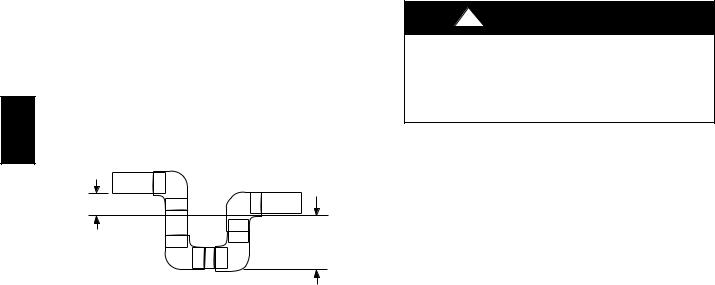
50VL--A
Step 6 — Connect Condensate Drain
NOTE: When installing condensate drain connection be sure to comply with local codes and restrictions.
Model 50VL-A disposes of condensate water through a 3/4 in. NPT fitting which exits through the base on the evaporator coil access side. See Fig. 2 and 3 for location.
Condensate water can be drained directly onto the roof in rooftop installations (where permitted) or onto a gravel apron in ground level installations. Install a field-supplied 2-in. (51 mm) condensate trap at end of condensate connection to ensure proper drainage. Make sure that the outlet of the trap is at least 1 in. (25 mm) lower than the drain pan condensate connection to prevent the pan from overflowing (See Fig. 8). When using a gravel apron, make sure it slopes away from the unit.
Connect a drain tube using a minimum of 3/4 -in. PVC or 3/4 -in. copper pipe (all field-supplied) at the outlet end of the 2-in. (51 mm) trap. Do not undersize the tube. Pitch the drain tube downward at a slope of at least 1-in. (25 mm) for every 10 ft (3.1 m) of horizontal run. Be sure to check the drain tube for leaks. Prime trap at the beginning of the cooling season start-up.
TRAP
OUTLET
1-in. (25 mm) min.
2-in. (51 mm) min.
A09052
Fig. 8 - Condensate Trap
Step 7 — Install Duct Connections
The design and installation of the duct system must be in accordance with the standards of the NFPA for installation of non-residence type air conditioning and ventilating systems, NFPA 90A or residence type, NFPA 90B and/or local codes and ordinances.
Select and size ductwork, supply-air registers, and return air grilles according to ASHRAE (American Society of Heating, Refrigeration, and Air Conditioning Engineers) recommendations. The unit has duct flanges on the supplyand return-air openings on the side of the unit.
When designing and installing ductwork, consider the following:
1.All units should have field-supplied filters or accessory filter rack installed in the return-air side of the unit. Recommended sizes for filters are shown in Table 1.
2.Avoid abrupt duct size increases and reductions. Abrupt change in duct size adversely affects air performance.
IMPORTANT: Use flexible connectors between ductwork and unit to prevent transmission of vibration. Use suitable gaskets to ensure weather-tight and airtight seal. When electric heat is installed, use fireproof canvas (or similar heat resistant material) connector between ductwork and unit discharge connection. If flexible duct is used, insert a sheet metal sleeve inside duct. Heat resistant duct connector (or sheet metal sleeve) must extend 24-in. (610 mm) from electric heater element.
3.Size ductwork for cooling air quantity (cfm). The minimum air quantity for proper electric heater operation is listed in Table 2. Heater limit switches may trip at air quantities below those recommended.
4.Seal, insulate, and weatherproof all external ductwork. Seal, insulate and cover with a vapor barrier all ductwork passing through conditioned spaces. Follow latest Sheet Metal and
Air Conditioning Contractors National Association (SMACNA) and Air Conditioning Contractors Association (ACCA) minimum installation standards for residential heating and air conditioning systems.
5.Secure all ducts to building structure. Flash, weatherproof, and vibration-isolate duct openings in wall or roof according to good construction practices.
CONFIGURING UNITS FOR DOWNFLOW (VERTICAL) DISCHARGE
!WARNING
ELECTRICAL SHOCK HAZARD
Failure to follow this warning could result in personal injury or death.
Before performing service or maintenance operations on the system, turn off main power to unit and install lockout tag.
1.Open all electrical disconnects and install lockout tag before starting any service work.
2.Remove horizontal (metal) ductcovers to access vertical (downflow) discharge duct knockouts in unit basepan. (See Fig. 9.)
To remove downflow return and supply knockout covers, break front and right side connecting tabs with a screwdriver and hammer. Push cover down to break rear and left side tabs.
NOTE: These panels are held in place with tabs similar to an electrical knockout. Reinstall horizontal duct covers (Fig. 9) shipped on unit from factory. Insure openings are air and watertight.
NOTE: The design and installation of the duct system must be in accordance with the standards of the NFPA for installation of nonresidence-type air conditioning and ventilating systems, NFPA 90A or residence-type, NFPA 90B; and/or local codes and ordinances.
Adhere to the following criteria when selecting, sizing, and installing the duct system:
1.Units are shipped for side shot installation.
2.Select and size ductwork, supply-air registers, and return-air grilles according to American Society of Heating, Refrigeration and Air Conditioning Engineers (ASHRAE) recommendations.
3.Use flexible transition between rigid ductwork and unit to prevent transmission of vibration. The transition may be screwed or bolted to duct flanges. Use suitable gaskets to ensure weather-tight and airtight seal.
4.All units must have field-supplied filters or accessory filter rack installed in the return-air side of the unit. Recommended sizes for filters are shown in Table 1.
5.Size all ductwork for maximum required airflow (either heating or cooling) for unit being installed. Avoid abrupt duct size increases or decreases or performance may be affected.
6.Adequately insulate and weatherproof all ductwork located
outdoors. Insulate ducts passing through unconditioned space, and use vapor barrier in accordance with latest issue of Sheet Metal and Air Conditioning Contractors National Association (SMACNA) and Air Conditioning Contractors of America (ACCA) minimum installation standards for heating and air conditioning systems. Secure all ducts to building structure.
7.Flash, weatherproof, and vibration-isolate all openings in building structure in accordance with local codes and good building practices.
8
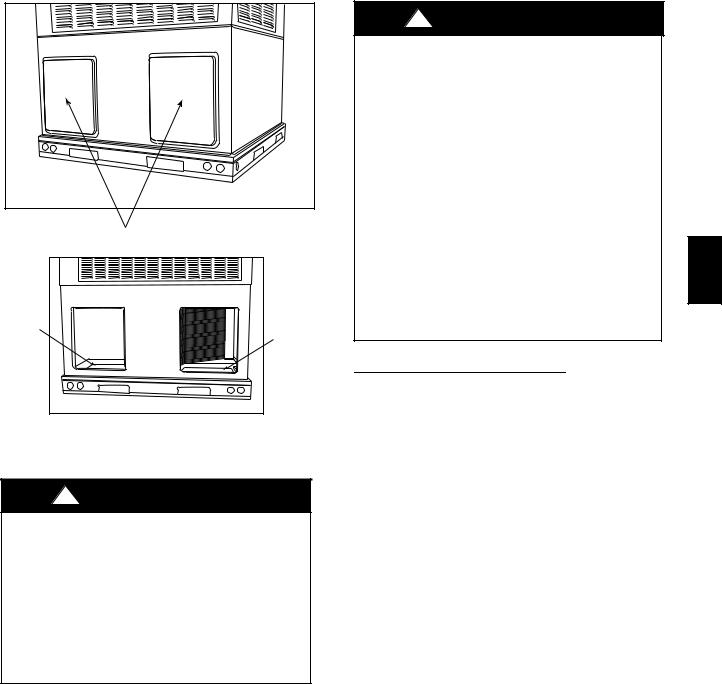
Horizontal Duct Covers
A09076
Basepan |
|
|
Downflow |
|
|
(Vertical) |
Basepan |
|
Supply |
||
Downflow |
||
Knockout |
||
(Vertical) |
||
|
||
|
Return |
|
|
Knockout |
|
|
A09093 |
Fig. 9 - Supply and Return Duct Opening
Step 8 — Install Electrical Connections
!WARNING
ELECTRICAL SHOCK HAZARD
Failure to follow this warning could result in personal injury or death.
The unit cabinet must have an uninterrupted, unbroken electrical ground to minimize the possibility of personal injury if an electrical fault should occur. This ground may consist of an electrical wire connected to the unit ground screw in the control compartment, or conduit approved for electrical ground when installed in accordance with NFPA 70 (NEC) (latest edition) (in Canada, Canadian Electrical Code CSA C22.1) and local electrical codes.
!CAUTION
UNIT COMPONENT DAMAGE HAZARD
Failure to follow this caution may result in damage to the unit being installed.
1.Make all electrical connections in accordance with NFPA 70 (NEC) (latest edition) and local electrical codes governing such wiring. In Canada, all electrical connections must be in accordance with CSA standard C22.1 Canadian Electrical Code Part 1 and applicable local codes. Refer to unit wiring diagram.
2.Use only copper conductor for connections between field-supplied electrical disconnect switch and unit. DO NOT USE ALUMINUM WIRE.
3.Be sure that high-voltage power to unit is within operating voltage range indicated on unit rating plate. On 3-phase units, ensure phases are balanced within 2 percent. Consult local power company for correction of improper voltage and/or phase imbalance.
4.Do not damage internal components when drilling through any panel to mount electrical hardware, conduit, etc.
HIGH-VOLTAGE CONNECTIONS
The unit must have a separate electrical service with a field-supplied, waterproof disconnect switch mounted at, or within sight from the unit. Refer to the unit rating plate, NEC and local codes for maximum fuse/circuit breaker size and minimum circuit amps (ampacity) for wire sizing.
The field-supplied disconnect may be mounted on the unit over the high-voltage inlet hole when the standard power and low-voltage entry points are used. See Fig. 2 and 3 for acceptable location.
See unit wiring label (Fig. 12, 13 and 14) and Fig. 10 for reference when making high voltage connections. Proceed as follows to complete the high-voltage connections to the unit.
Single phase units:
1.Run the high-voltage (L1, L2) and ground lead into the control box.
2.Connect ground lead to chassis ground connection.
3.Locate the black and yellow wires connected to the line side of the contactor.
4.Connect field L1 to black wire on connection 11 of the compressor contactor.
9
50VL--A
